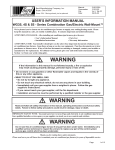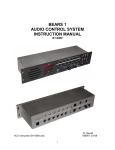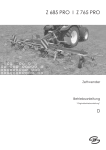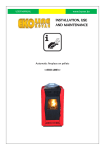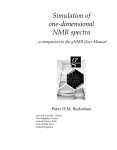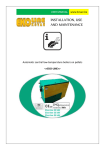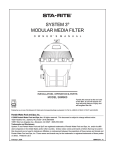Download 3Com 43506 Dishwasher User Manual
Transcript
Manual: Supersedes: File: Date: BARD MANUFACTURING COMPANY Bryan, Ohio 43506 Since 1914...Moving ahead, just as planned. 2100-279 Vol I, Tab 20 04-19-98 USER'S INFORMATION MANUAL WAG-Series Combination Gas/Electric Wall-Mount™ We're pleased you've chosen our gas furnace to supply your heating needs. Please keep this manual in a safe, yet readily available place. It contains important and useful information. ATTENTION, INSTALLER: After installing furnace, give the user: • User's Information Manual • Installation Instructions • Parts List • Warranty Information ATTENTION, USER! Your furnace installer should give you the above four important documents relating to your furnace. Keep these as long as you do your furnace. Pass these documents on to later purchasers or furnace users. If any of the four documents are missing or damaged, contact your installer or furnace manufacturer for replacement. For efficient service, please give your furnace model and serial number, from Section 1 or from your furnace rating plate. WARNING If the information in this manual is not followed exactly, a fire or explosion may result causing property damage, personal injury or loss of life • Do not store or use gasoline or other flammable vapors and liquids in the vicinity of this or any other appliance. • WHAT TO DO IF YOU SMELL GAS • Do not try to light any appliance. • Do not touch any electrical switch; do not use any phone in your building. • Immediately call your gas supplier from a neighbor's phone. Follow the gas supplier's instructions. • If you cannot reach your gas supplier, call the fire department. • Installation and service must be performed by a qualified installer or the gas supplier. WARNING Read and follow all safety information in this manual, operating instructions and furnace safety labels. Failure to follow safety precautions could result in damage, injury or death. IMPORTANT SAFETY NOTE: You must know how to turn off gas and electricity to furnace. Your qualified installer, service agency or gas supplier can teach you to use controls and switches. WARNING Do not use this furnace if any part has been under water. Immediately call a qualified service technician to inspect the furnace and to replace any part of the control system and any gas control which has been underwater. Thank you for reading these safety statements. Please read on so you will know how to maintain your furnace for years of dependable service. Contents Section 1 Rating Plate Information ....................................... 1 Figures Figure 1 Typical Gas Piping .............................. 4 Section 2 Important Safety Precautions ............................... 1 Figure 2 Step-by-Step Instructions on Lighting Burners ............................. 6 Section 3 Understanding How Your Furnace Works ............ 3 Figure 3 Filter Locations ................................... 9 Figure 4 Location of Access Panels ................. 9 Figure 5 Pilot Flame Adjustment ..................... 10 Figure 6 Main Burner Flame Adjustment ......... 10 Figure 7 Start Up Procedures ......................... 10 Figure 8 Air Damper Positions ........................ 10 Section 4 Turning Off Furnace in an Emergency .................. 4 Section 5 Operating Your Furnace ....................................... 6 Section 6 Proper Maintenance of Your Furnace ................... 7 Section 7 Air Conditioning Start Up Procedure Crankcase Heater .............................................. 10 Section 8 Fresh Air Damper Assembly .............................. 10 Section 9 Replacement Parts ............................................ 11 COPYRIGHT APRIL 1988 BARD MANUFACTURING COMPANY BRYAN, OHIO USA 43506 SECTION 1 • RATING PLATE INFORMATION Record the manufacturer’s name, unit model number and serial number below. These are your furnace rating plate. Record installation date which is important for warranty purposes. YOUR FURNACE INFORMATION Furnace Type ___________________________________________________________________ Manufacturer’s Name _____________________________________________________________ Model Number __________________________________________________________________ Serial Number ___________________________________________________________________ Date Installed ___________________________________________________________________ Installer/Servicer _________________________________________________________________ Address ________________________________________________________________________ City/State/Zip Code _______________________________________________________________ Telephone Number ________________________________________________________ SECTION 2 • IMPORTANT SAFETY PRECAUTIONS 2.A HAZARD ALERT SYMBOL An explanation point surrounded by a triangle. 2.B SIGNAL WORDS Years of safe, dependable service are assured when you understand and follow all safety precautions. Signal words “WARNING” and “CAUTION” alert you to potential hazards. “WARNING” indicates a potentially hazardous situation which, if not avoided, could result in death or serious injury. “CAUTION” indicates a potentially hazardous situation which, if not avoided, may result in minor or moderate injury. It may also be used to alert against unsafe practices. It can also be used to signal property damage only potential. 2.B. SAFETY PRECAUTIONS These are some of our most important safety precautions; others are throughout this manual. Please read and follow them. 2.1 GAS AND COMBUSTION PRODUCTS WARNING Any condition that will allow gas of combustion products to enter furnace area can cause nausea, asphyxiation or fire resulting in damage, injury or death. Natural gas and propane (LP) gas have characteristic odors. When your furnace is operating correctly, you should not smell any unfamiliar odor. Normally, burning gas with air produces combustion products which contain carbon dioxide, oxygen and water vapor. Under abnormal conditions, combustion products and contain aldehydes and carbon monoxide. • Aldehydes have a strong pungent, acrid smell that can cause nausea. • Carbon monoxide is tasteless, colorless and odorless. It can cause headaches, flu-like symptoms or nausea. We refer to all these symptoms as nausea in this manual. It can also cause death by asphyxiation. Manual 2100-279 Page 1 WARNING WARNING Any unfamiliar smell can alert you to presence of gas or aldehydes. If you detect any unfamiliar odor follow instruction in Section 4.B.1. Otherwise, nausea, asphyxiation or fire could occur resulting in damage, injury or death. Do not operate furnace with blower door open or removed. Do not alter furnace to allow operation with blower door removed. Doing either could allow combustion products to circulate throughout the furnace area causing nausea, asphyxiation or fire resulting in damage, injury or death. WARNING WARNING Do not block or cover combustion openings in the furnace door or closet door. Blocking or covering these openings could cause nausea, asphyxiation or fire resulting in damage, injury or death. WARNING Do not block or cover any openings from outside the furnace area which supply combustion and ventilation air to your furnace. Keep insulation away form these openings. Blocking or covering these openings could cause nausea, asphyxiation or fire resulting in damage, injury or death. WARNING A loud noise may mean faulty burner ignition. If your furnace makes a loud noise, turn it off. Follow instructions in Section 4.B.2. If you don’t turn off your furnace, it could cause fire or an explosion resulting in damage, injury or death. WARNING If your furnace is in an attic or other insulated space, keep all insulating materials at least 12 inches away from its burner combustion air openings. Block or covering these openings could cause nausea, asphyxiation or fire resulting in damage, injury or death. Examine furnace area when the furnace is installed or when insulation is added to that area. Insulation materials may be combustible. Manual 2100-279 Page 2 Front door must be in place during furnace operation. Hot surfaces behind front door. 2.2 STORAGE AND USE OF FLAMMABLE, CORROSIVE AND COMBUSTIBLE PRODUCTS NEAR YOUR FURNACE WARNING Never store or use flammable liquids or vapors near or on your furnace. These include gasoline, kerosene, cigarette lighter fluid, cleaning fluids, solvents, paint thinners or painting compounds. Flammable vapors can travel great distances before igniting. WARNING Never store or use anything near or on your furnace that can produce vapors that are corrosive to gas-fired furnaces. Vapors from products containing chlorines, fluorines, bromines and iodines can cause vent system or heat exchanger failure. Examples of such products are spray or aerosol containers, detergents, bleaches, cat litter, waxes, adhesives, solvents and other cleaning compounds. Vent system or heat exchanger failure could cause nausea, asphyxiation or fire resulting in damage, injury or death. WARNING Never store anything combustible near or on your furnace. These include brooms, dustmops, vacuum cleaners, other cleaning tools or items, plastic or plaxtic containers, paper bags or other paper products. A fire could occur resulting in damage, injury or death. 2.3. ALTERATION OF FURNACE CONTROLS WARNING Do not alter any gas or electrical controls (gas control, pilot or safety controls) in any manner. Altering them could cause furnace to operate unsafely resulting in damage, injury or death. SECTION 3 • UNDERSTANDING HOW YOUR FURNACE WORKS Your installer should have given you a detailed explanation of how the furnace operates. Shown below are the basic operation characteristics and sequence of operation. If you have any questions consult your installer and/or service agency. * * IMPORTANT * * There are many types of thermostats compatible with this furnace. Make sure you understand the specific type installed. Ask installer for detailed explanation, and retain thermostat instruction manual for reference. This furnace is equipped with a vent shut-off system which monitors the combustion air into the burners by means of a pressure sensing device. When the vent becomes blocked, this device turns off the gas valve circuit to prevent flue products from entering the structure. In the event that this occurs, shut off furnace and contact a qualified service agency. 3.1 BASIC OPERATION – HEATING CYCLE This furnace is operated by an Electronic Blower Control (EBC) and a gas control system which controls all functions of the furnace. On a call for heat from the thermostat, the EBC first turns on the inducer motor. The pressure switch then closes signaling the ignition control to proceed with ignition function. The ignition system consists of an intermittent pilot with a hot surface igniter to light pilot burner, senses flame, and then main gas valve opens with pilot flame lighting main burners. There is a 60 second delay after main burner is on until the comfort air blower starts on heating (low) speed. After the thermostat is satisfied, the burners will go off as gas valve closes. The inducer will continue to run for 5 seconds, and the comfort air blower will continue to run for two minutes. 3.2 BASIC OPERATION – COOLING CYCLE On a call for cool the compressor and condenser fan will start immediately, and the comfort air blower will start 6 seconds later on cooling (high) speed. When the thermostat is satisfied the compressor and condenser fan will stop, and the comfort air blower will continue to operate for 60 seconds. 3.2.1 COMPRESSOR LOCKOUT (CANADIAN UNITS ONLY) The units built for Canadian use are equipped with high and low pressure controls. These controls protect the compressor from extreme conditions such as high refrigerant pressure or a loss of charge. When this happens the compressor is held off line by a lock out relay. To reset the lock out relay, the thermostat must be set to the “OFF” position and then returned to the normal operating position. The compressor is now allowed to function. If the compressor continues to lock out, service personnel should be called to check the unit. 3.3 MANUAL FAN (CONTINUOUS AIRFLOW) OPERATION If wall thermostat is set to MANUAL (ON) position to operate comfort air blower continuously to provide air circulation throughout the building, the blower will operate on the heating speed rather than the cooling as is typical with most systems. This permits the air to circulate as desired but helps keep the operating noise level down as well as conserving energy. During a call for cooling, the blower automatically shifts up to cooling speed, and remains there until 60 seconds after thermostat is satisfied then drops back to heating speed. Manual 2100-279 Page 3 SECTION 4 • TURNING OFF FURNACE IN AN EMERGENCY FIGURE 1 – TYPICAL GAS PIPING WARNING Have a qualified installer, service agency or gas supplier teach you location and operation of gas and electrical shutoff devices. Ask them any questions you have about this section. If you don’t turn off your furnace in an emergency damage, injury or death could result. In an emergency you MUST know how to turn off gas and electricity. Find out how BEFORE THE EMERGENCY. WARNING Should overheating occur or the gas supply fail to shut off, shut off the manual gas valve to the furnace before shutting off the electrical supply. Failure to do so can cause a fire or explosion which could result in damage, injury of death. 4.A GAS AND ELECTRICAL SHUTOFF DEVICES 1. GAS SHUTOFF DEVICES In an emergency, you may not be able to reach all the gas shutoff devices. You must know how to turn off gas using any one of the three manual types: a. Manual Shutoff Switch on Gas Control Gas control location is behind the middle access panel on the right side. See Lighting and Shutdown Instructions in Section 5 for more informantion. To turn gas control furnace switch OFF, switch it to “OFF” position. Use this same procedure when you leave a vacation home vacant and do not want the furnace to operate. b. Manual In-Line Shutoff Valve in Gas Supply Line This valve is next to furnace. Figure 1 shows a typical installation. Normally, gas is ON when you turn the shutoff valve handle parallel to gas pipe. Gas is OFF when you turn handle 90° from gas pipe. Manual 2100-279 Page 4 c. Manual Shutoff Valve at Natural Gas Meter or Propane (LP) Gas Tank Normally, natural gas is ON when you turn shutoff parallel to gas pipe. Gas is OFF when you turn shutoff 90° from gas pipe. Some valves require a wrench or other tools. 2. ELECTRICAL SHUTOFF DEVICES In an emergency, you may not be able to reach both of your electrical shutoff devices. Therefore, you must know how to turn off electricity using either one of them. Here are two types of electrical shutoff devices: a. There should be an electrical shutoff device located on or immediately adjacent to the furnace. b. There should be a separate circuit breaker or fuse serving only the furnace located in the main circuit breaker or fuse panel. Know its location and make sure this device is clearly identified. 4.B POSSIBLE EMERGENCIES AND RECOMMENDED ACTIONS WARNING If gas or electricity is off due to an emergency, only a qualified installer, service agency or gas supplier should turn it back on. Doing it yourself could result in damage, injury or death. c. Your furnace should now be off. If it is, call your service technician or gas supplier. d. If your furnace continuers to run, leave your home or building immediately. Call your gas supplier or fire department from a neighbor’s phone for help. 3. Possible Emergency: Your thermostat is set above room temperature. The blower is on but the air coming from your room registers is hot, then cold, then hot, then cold in a continuing cycle. This condition indicates lack of airflow through furnace. ACTION: 1. Possible Emergency: Smelling gas or other unfamiliar smell; or not knowing what may be wrong or that to do about it. ACTION: For your safety – a. Leave your house or building immediately. b. Go to a neighbor’s or another building. c. Use their telephone. d. Call your gas supplier. Tell them you smell gas and give them your name and address. a. Make sure air filter is clean and installed correctly. b. Check that registers and return air grilles are open and unobstructed. c. If condition continues, call your local qualified service technician or gas supplier. 4. Possible Emergency: While furnace is operating, you smell unfamiliar odors that go away when furnace is off. e. If you cannot reach gas supplier, call fire department. WARNING Three important things not to do – 1. Don’t try to light any gas appliances. 2. Don’t touch any electrical switches 3. Don’t use the telephone in your house or building. Any of the above may cause a spark which could cause a fire or explosion resulting in damage, personal injury or death. 2. Possible Emergency: Your thermostat is set below room temperature; yet even though the blower is on, the air coming from your room registers continually gets hotter. ACTION: a. Turn room thermostat to its lowest or OFF setting. b. If you can do so safely, turn gas off. Use manual shutoff valve at gas meter or on propane (LP) gas tank. You may need a wrench or tools. If you can safely turn off electricity at the main circuit panel, do so. If you cannot do these things safely, leave your home or building immediately. Call your gas supplier or fire department from a neighbor’s phone for help. WARNING Unfamiliar odors may mean gas or aldehydes are present which could result in damage, injury or death. ACTION: a. Turn thermostat to its lowest or OFF setting. b. Move gas valve control level to OFF. c. If blower is not operating, immediately turn of electricity to furnace using shutoff device near furnace or at main circuit panel. d. If blower is operating, wait five minutes for furnace to cool down and then turn off electricity to furnace using shutoff device near furnace or at main circuit panel. e. Call your local qualified service technician or gas supplier. 5. Possible Emergency: Main electrical circuit breaker for furnace cannot be reset without tripping again or new fuses continue to blow. ACTION: a. Move gas valve control level to OFF. b. Call your local qualified service technician or gas supplier. Manual 2100-279 Page 5 SECTION 5 • OPERATING YOUR FURNACE After reading the Safety Information and Precautions follow Operating Instructions on front door of furnace and instructions repeated here. WARNING If you do not follow these instructions exactly a fire or explosion could occur resulting in damage, injury or death. WARNING Never use tools to move gas control switch. Only use your hand. If gas control switch will not move by hand, do not force it or try to repair it. Call a qualified installer, service agency or gas supplier. Forcing switch can cause gas to leak which could result in fire or explosion. Properly operating your furnace requires certain abilities, mechanical skills and tools. If you are uncertain about your abilities or if you lack proper skills or tools, do not proceed. Instead, contact a qualified installer, service agency or gas supplier. An automatic ignition device lights the burners. Do not try to light manually. See Figure 2 for step by step instructions. FIGURE 2 Manual 2100-279 Page 6 SECTION 6 • PROPER MAINTENANCE OF YOUR FURNACE 6.D KEEP AIR FILTER(S) CLEAN As a user, your personal responsibility is to keep air filter(s) clean. You need special abilities, mechanical skills and tools to maintain your furnace properly. If you are uncertain about your abilities or if you lack proper skills or tools, do not try to maintain or repair you furnace yourself. Instead, contact a qualified installer, service agency or gas supplier. CAUTION A dirty air filter(s) reduces system efficiency and can cause erratic control performance. These could result in damage to blower motor or heat exchanger. 6.A IF YOU SMELL GAS OR ANY UNFAMILIAR SMELL WHILE WORKING ON YOUR FURNACE: 1. Do not try to light main burners. 2. Do not touch or turn on any electrical switch. 1. During the first four weeks after your furnace is installed, inspect your air filter(s) for dirt every week. Then check the filters monthly and clean as necessary. 3. Do not use any phone in your building. 4. Immediately call your gas supplier from a neighbor’s phone. Follow gas supplier’s instructions. 2. If the filter(s) is of a washable type, clean filter(s) according to the manufacturer’s specifications. 5. If you cannot reach your gas supplier, call fire department. WARNING 6.B LUBRICATION REQUIREMENTS The main blower motor and the induced draft blower motor are permanently lubricated, and no maintenance is required. After cleaning or changing filter(s), filter access cover(s) must be replaced. Failure to do so could cause nausea, asphyxiation, or fire resulting in damage, injury or death. 6.C MAKE SURE AIR FILTER(S) IS IN PLACE Ask your installer, local qualified service technician or gas supplier to make sure your filter(s) is in place properly. Become familiar with its location and procedures for removing, cleaning and replacing it. 6.E DO NOT OBSTRUCT DUCT WORK For proper operation, keep registers and return air grilles open. Do not cover or block them with rugs, carpets, drapes or furniture. Recommended filter sizes are shown below. 6.F MAIN SYSTEM FILTER: 20 X 30 X 1 Fiberglass disposable FRESH AIR FILTER: 4 x 26 x 1/2 Washable See Figure 3 for filter locations. WARNING Operating furnace without clean air filter(s) can damage blower motor, heat exchanger or air conditioning system components. This can cause system failure which could result in damage or injury. HAVE YOUR FURNACE CHECKED ANNUALLY The furnace, vent terminal, and the combustion air intake hood should be inspected yearly by a qualified service agency, generally prior to the heating season. Detailed procedures for this inspection are contained in the instructions booklet and should be handled by the qualified service agency only. A general inspection of the furnace, the furnace area and the vent terminal should be conducted on a regular basis by the owner/occupant. This review should include: 1. Make sure the furnace always has the minimum clearance as detailed on the furnace rating plate. Special attention must be given to these items if any remodeling is done. 2. Make sure the vent terminal is in place and is physically sound. Manual 2100-279 Page 7 3. Reviewing that the return air duct connection(s) is physically sound, is sealed to the furnace casing. 4. The physical support of the furnace is sound without sagging, cracks, gaps, etc. around the unit so as to provide a seal between the unit and the structure. 5. Inspect for any obvious signs of deterioration of the furnace. 6. Periodic examinations of the vent terminal should also be conducted by the owner on a regular basis, preferably every monthly but at least every two months during the heating season. 7. Check the entire vent terminal for any blockage. If any debris is present remove it. 6.G THE FOLLOWING PROCEDURE SHOULD BE FOLLOWED FOR THE PERIODIC INSPECTION AS CONDUCTED BY THE OWNER/OCCUPANT. 1. Set the wall thermostat to the OFF position or lower the set point lever to a temperature will below the existing room temperature. Shut off electric power to the furnace. A switch should be mounted either on the outside of the furnace or adjacent to the furnace for this purpose. 2. Remove the burner access door. See Figure 4. 3. Use flashlight or trouble light to observe the burner compartment and burners. There should be very minimal scaling or sooting in this area. Some loose debris may have fallen down on to the floor of the heat exchanger form the tube passageways, and this may be vacuumed out. Also observe the sides of the heat exchanger tubes for “hot spots” due to improper burner alignment or overfiring and give particular attention to any area where it looks like there may be any deterioration from corrosion or rusting. Observe for any corrosion on the burners themselves. Should anything appear questionable, contact your service agency. Manual 2100-279 Page 8 4. Inspect the vent terminal, observing for any debris from weather, birds, and the like. Clean if necessary. Also check the small cover assembly on Induced Draft Blower Door to make sure it is clear. See Figure 4. WARNING Leakage of products of combustion into the living area may result in asphyxiation resulting in injury or death 5. Restore the electrical power to the furnace by turning the switch back on. Adjust the thermostat to call for heating operation. 6. Observe both the pilot flame and main burners flames, and compare to Figures 5 and 6 respectively. The main burners should be mostly “blue” with possibly a little orange (not yellow) at the tips of the flames. The flames should be in the center of the heat exchanger compartments and impinging on the heat exchanger surfaces. 7. Observe the flames until the blower starts (there is a normal delay 60 second period until the heat exchanger warms up). There should be no change in the size or shape of the flame. If there is any wavering or blowing of the flame on the blower start-up, it is an indication of a possible leak in the heat exchanger. Turn off the gas valve in the gas line leading to the furnace, and then the main electrical switch to the furnace and call your service agency. 8. Replace the burner access door. FIGURE 3 MIS-058 FIGURE 4 MIS-059 Manual 2100-279 Page 9 FIGURE 5 FIGURE 6 FLAME SHOULD ENGULF SENSOR GROUND STRAP IGNITER HEAT EXCHANGER SECTION SENSOR OUTER CONE INNER CONE NO LIFTING AWAY FROM BURNER PORTS MIS-1067 SECTION 7 • AIR CONDITIONING START UP PROCEDURE CRANKCASE HEATERS SECTION 8 • FRESH AIR DAMPER ASSEMBLY Single and three phase models have an insertion well-type heater located in the lower section of the compressor housing. This is a self-regulating type heater that draws only enough power to maintain the compressor at a safe temperature. The fresh air damper assembly permits outside fresh air to be introduced to the building whenever the main unit comfort air blower is operating. The damper blade may be set to one of four positions: 1) full open, 2) 50% open, 3) full closed, or 4) automatic (barometric) operation. In the latter set-up the damper blade will open and close as the main comfort air blower cycles on and off. Reference Figure 8 for details on damper positions. Some form of crankcase heat is essential to prevent liquid refrigerant from migrating to the compressor, causing oil pump out on compressor start-up and possible valve failure due to compressing a liquid. The decal in Figure 7 is affixed to all outdoor units detailing start-up procedures. This is very important. Please read carefully. FIGURE 7 IMPORTANT There is also a cleanable filter installed at the bottom opening of the fresh air damper that requires periodic cleaning. The cleaning interval will be dependent upon frequency of unit operation and local air conditions. See Figure 3 for Fresh Air Damper and filter locations. FIGURE 8 These procedures must be followed at initial start-up and at any time power has been removed for 12 hours or longer. To prevent compressor damage which may result from the presence of liquid refrigerant in the compressor crankcase. 1. Make certain the room thermostat is in the “off” position (the compressor is not to operate). 2. Apply power by closing the system disconnect switch. This energizes the compressor heater which evaporates the liquid refrigerant in the crankcase. 3. Allow 4 hours or 60 minutes per pound of refrigerant in the system as noted on the unit rating plate, whichever is greater. 4. After properly elapsed time, the thermostat may be set to operate the compressor. 5. Except as required for safety while servicing—Do not open system disconnect switch. 7961-061 Manual 2100-279 Page 10 FULL OPEN NORMAL BAROMETRIC POSITION 50% OPEN FIXED POSITION. (2) ADDTIONAL CANOE CLIPS ARE TAPED TO THE INSIDE OF DAMPER ASSEMBLY TOTALLY CLOSED POSITON MIS-957 SECTION 9 • REPLACEMENT PARTS Replacement parts for the gas/electric units are available through local distributors. A replacement parts list manual is supplied with each unit. When ordering parts or making inquiries pertaining to any of the units covered by these instructions, it is very important to always supply the COMPLETE model number and serial number of the unit. This is necessary to assure that the correct parts (or an approved alternate part) are issued to the service agency. Manual 2100-279 Page 11













